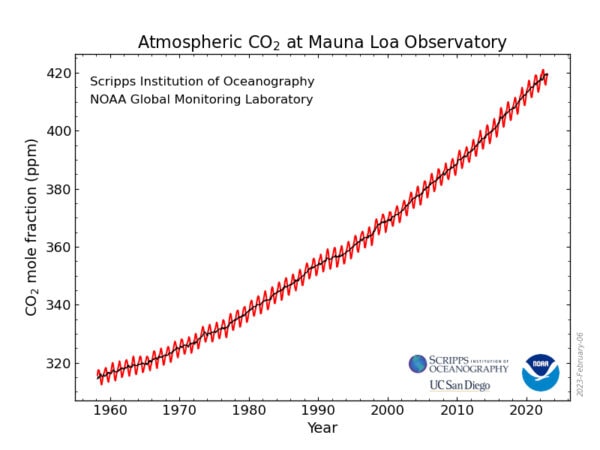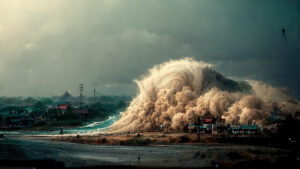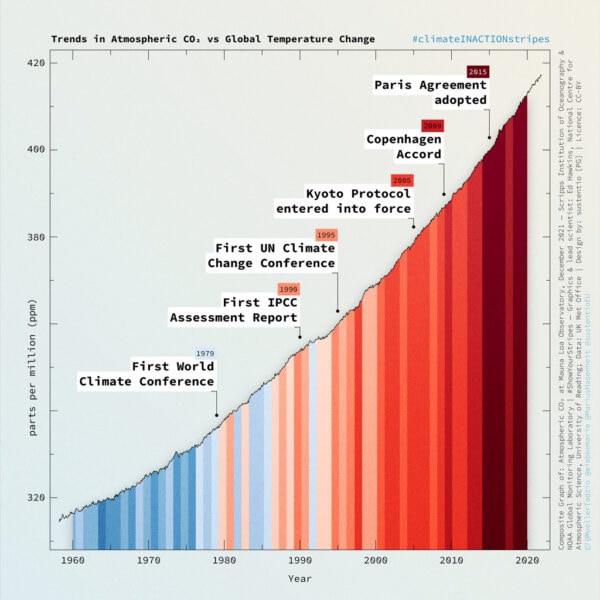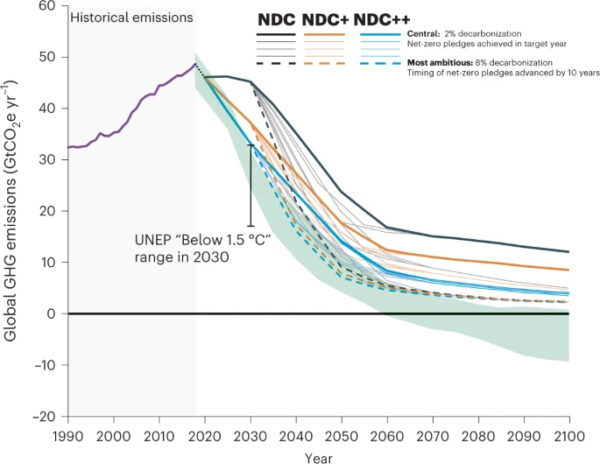
Anthropogenic climate change will be part of the lives of both this generation and those to come. Human activities have changed terrestrial dynamics to the point that mechanisms for adaptation are needed, as are urgent measures to decarbonize the economy.
What is climate change?
Climate change is all the variation in the terrestrial climate system over a period of more than a decade. However, this term is used to refer to the current climate change.
Anthropogenic climate change, change due to human activities, is the change we’ve seen since approximately the Second Industrial Revolution (1850 CE). However, there were other much smaller ones, like what the Mayan civilization generated, or the ones caused by European civilizations through deforestation and Chinese civilizations by growing rice.
Greenhouse effect, climate change, global warming, and climate crisis
Many of the terms associated with the current climate imbalance often get confused with one another; while they are related, they are not formally the same thing:
The greenhouse effect is the phenomenon where the atmosphere and the ocean warm due to the greenhouse gases (GHG) retaining heat. The Keeling curve shows the concentration of CO₂ on Mauna Loa for as long as records have been kept.

The Keeling curve, according to the observatory on Mauna Loa
Global warming is the direct result of that greenhouse effect. It has to do with the heating itself and is expressed in units of temperature, like degrees Celsius or Fahrenheit. The global temperature has increased significantly (1ºC, 2ºF) compared to pre-industrial levels.
The term climate change has been heavily criticized as a concept since its adoption because it can lead to the mistaken thought that the current change is natural; using the term anthropogenic climate change instead is recommended because it is due to humankind.
This concept includes not only GHG or temperature increases but also all other consequences: sea level rise, melting ice, loss of biodiversity and mass extinctions, the appearance of diseases, migrations, famines, ocean acidification, adverse weather events, etc.
The concept of a climate crisis is gaining momentum both within the scientific community and in specialized media due to the urgency of reducing emissions and the current effects of their appearance. For a few years now, CO₂ has far exceeded its planetary limits.
Factors that cause climate change
The main causes of anthropogenic global warming are the release of greenhouse gases, changes made to the landscape to accommodate human activities (for example, deforestation), and the release of aerosols, though there are others, such as the decomposition of microplastics and many more.

How to solve climate change
To date, attempts to solve anthropogenic climate change have been unambitious. The first climate conference in 1979, the first IPCC report in 1990, and the Paris Agreement have failed to curb carbon emissions, which accumulate in the atmosphere and increase temperatures there. The following infographic, with the latest scientific data, brings all this information together.

An infographic that combines the accumulation of CO₂ ppp, the different climate milestones, and the temperature increase. | ClimateINACTIONStripes
There are two strategies that must be maintained alongside each other in order to live in a world experiencing climate change:
Mitigation of the climate crisis
The strategies for climate change mitigation aim to reduce the greenhouse effect. Although some geoengineering solutions are being assessed at a theoretical level, priority is currently given to two main areas:
- Drastically reducing greenhouse gas emissions. To date, humanity has not been able to reduce its global net emissions; they continue to increase decade by decade. The challenge is that the longer we wait, the more difficult it will be to comply with the Paris Agreement. The graph shows several scenarios for decarbonizing starting in 2018 within safe limits (green band). As of 2018, it needed to be reduced by 8% annually.

- Capturing the atmospheric carbon already discharged into the atmosphere and into the ocean as soon as possible. The winning strategy is to reforest large swaths of forest, including the urban forest because it is the cheapest, the lowest maintenance, and the one with the most benefits. There are, however, also some interesting complementary technologies, such as carbon capture (still in development and unscalable).
Adapting to the climate crisis
The strategies for adapting to the climate crisis focus on living with already inevitable global warming (it is inevitable but modular: every kilogram of CO₂ collected or not emitted will make the future less dangerous). These include:
- Building more resilient habitats. There is a lot of talk about urban solutions, such as a perimeter with vegetation or including vegetation to cool the city or create shade. In some coastal areas, mangrove restoration is thought to reverse coastal erosion. More and more countries are adopting constructive ways that work with water instead of against it (sponge cities).
- Planting crops that are resistant to both pests and heat. The increase in temperature will push humanity’s ability to feed itself to the limit.
- Changes in habits. In recent years, stricter guidelines have been put on outdoor work in summer to prevent heat stroke, as well as recommendations for residents to avoid playing sports at certain times.
It is important to note that there are limits to adaptation, both physical and economical, so the necessary course is still the climate change mitigation strategies.
Main image: Ashim D’Silva,





There are no comments yet